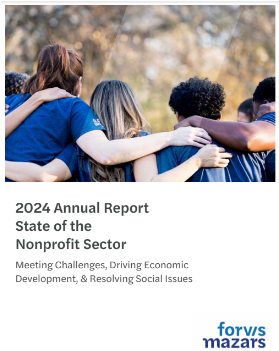
Doing Poorly by Doing Good
The top five challenges faced by nonprofits in 2024 included rising operating expenses; lack of adequate finances/resources; limited staff capacity; difficulty recruiting and retaining quality staff; and economic downturn/inflation.

That’s according to the 2024 State of the Nonprofit Sector Report, which draws on data from a sample of organizations across the US.
While struggling with those and other challenges, nonprofit programs and services also saw the demand for their services increase by 71 percent.
As a result, the nonprofit workforce, which is 70 to 75 percent female, is suffering.
How bad is it? Nationally, more than one in five nonprofit employees could not make ends meet, according to a report from Independent Sector, in partnership with United for ALICE (the acronym stands for Asset Limited, Income Constrained, Employed). While some employees are on public assistance, others make too much money to qualify, but not enough to get by. Not surprisingly, workers of color and workers with disabilities were far more likely to struggle than workers who are white.
For funders, this begs the question: are we investing in the wellbeing of some people (the aging recipients of services we fund) but at the expense of other people (the providers of the services we fund)? And what about the providers, who are themselves aging? The health and human services workforce has a median age of 42. What are their prospects for financial security in later life? What can funders do about this vicious cycle?
In New York, funders are speaking out. Under the leadership of Kathryn O’Neal-Dunham, Philanthropy New York has been active in the #JustPay movement.

#JustPay, which is led by the Human Services Council, advocates for increased wages and a true cost of living standard for nonprofit employees.
They’ve made considerable progress since they started in 2021, securing $1.4 billion in wage increases for city-contracted human services workers and a 3% COLA every year for the next three years.
In addition to taking a public stand, we can initiate honest conversations with our nonprofit partners about the real costs of a project. Nonprofits have long been incentivized to do more with less. During a recent presentation of a new (and very impressive) data dashboard, the nonprofit creator told a group of funders that the dashboard, which was at least $100,000 worth of work, was developed for $10,000 because most of the cost was “just my time.” As funders, we should value people’s time and intellectual capital.
We can proactively review the personnel lines of our grant budgets and increase them if possible. Even if the personnel line was determined by the applicant, does it seem low? For example, if we’re funding a poverty-reduction program for older people, are we paying the program staff poverty-level wages? Though initially cheaper, underfunding personnel results in significant costs because of the challenges of recruitment and retention. Unfilled positions and high turnover negatively impact outcomes.
A career helping older people who are struggling and economically insecure should not consign nonprofit staffers to the same fate. By joining the fight to fairly compensate the workforce, philanthropy can help to strengthen the nonprofit sector, improve the quality of services delivered, and maximize our dollars and our impact. #JustPay.